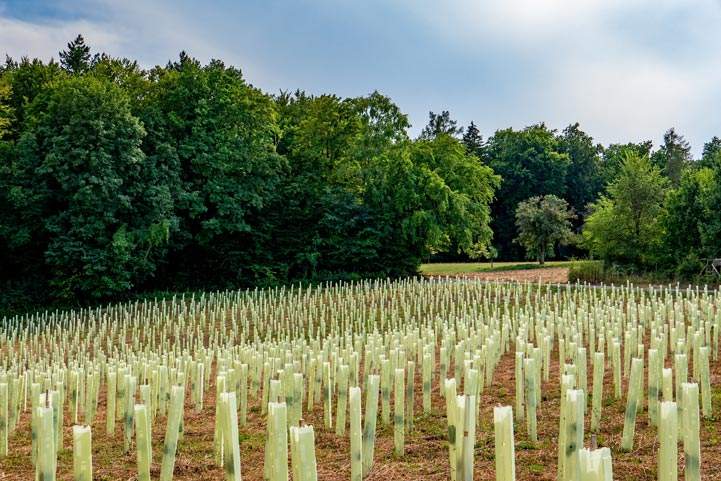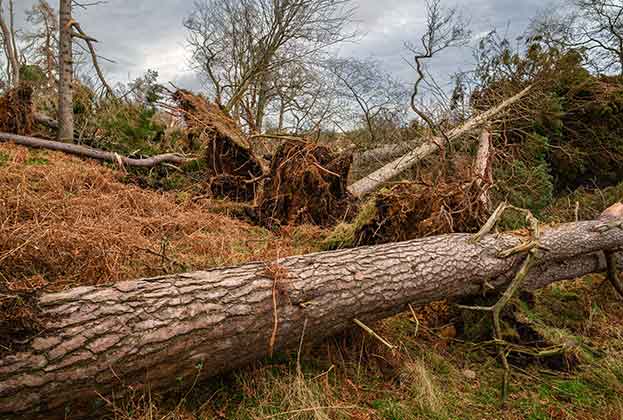While it is unlikely that UK tree planting targets will be met, there is a renewed appetite for woodland creation
While the achievement of 13,000 hectares of new woodland created in the UK during the 2023 planting year is positive, it is a long way from achieving the UK’s ambitious target of planting 30,000 hectares of new woodland annually from 2025 onwards (figure 6).
If the target of increasing woodland cover from 13% (2020) to 17–19% by 2050 across all devolved governments is to be met, more needs to be done to increase delivery of new planting schemes. Indeed, since 2020 the area of the UK covered by woodland has increased by just 0.4%. At this rate of growth, it is likely the UK will fall short of this target by 1–3%, only achieving 16% coverage (Forestry Commission Key Performance Indicators reports 2020 to 2023).
Tree planting performance
During 2023, new planting across the UK reached only 43% of the overall target of 30,000 hectares, ranging from 55% in Scotland to 20% and 24% in Northern Ireland and Wales, respectively, and only 11% in England.
- England: If tree planting for the 2024 planting year follows the same pattern as the previous planting year, provisional planting figures at 30 September 2023 indicate that England is in line to hit 67% (5,000 hectares) of the 7,500 hectare annual target of new woodland.
However, on 18 March 2024, the Forestry Commission announced a streamlined process for the England Woodland Creation Offer (EWCO), which aims to reduce the processing time of less complex claims to a minimum of 12 weeks and drive planting performance to exceed that achieved in previous years.
The EWCO pays up to £10,200 per hectare for tree planting on land identified as having low sensitivity for tree planting (few or no constraints on land use change, excluding grade 1 and 2 agricultural land and habitats likely to inhibit tree growth). This is in addition to rate uplifts for maintenance payments (from £350–£400 per hectare) and many of the additional contributions (totalling an increase up to £12,700 per hectare from £9,100).
It also introduces a low-sensitivity land payment to encourage tree planting in these areas. Where proposed new woodland sites contain a mix of sensitivity for woodland creation, it may be advisable to split the area into multiple parcels for separate applications. This will allow planting to commence in simpler landscapes while more complex negotiations take place for other parcels.

- Scotland: According to Nature Scot, the planting target is 15,000 hectares per annum; however, recent budget announcements by the Scottish government confirm significant budget cuts to the Forestry Grant Scheme, meaning it will only be able to support delivery of 9,000 hectares (60%) of new woodland in the 2024/25 financial year, further reducing to 4,000 hectares (27%) in 2025/26. This leaves the remaining 6,000 hectares per annum (40%, rising to 11,000 hectares, 73% for 2025/26) of planting to meet the net zero by 2045 target to be postponed pending further review, or be funded through private schemes such as the woodland carbon code, or third party investment.
- Wales: The Welsh government’s policy on tree planting is currently meeting a great deal of resistance from farmers and landowners. The policy of setting aside 10% of all agricultural land for tree cover, including, new planting where required, has been widely criticised as being unrealistic. There are concerns that it is in direct contrast to the recent announcements by the Forestry Commission as it does not target planting trees in areas most appropriate for land use and tree survival.
While most land in Wales is unsuitable for arable food production it is suitable for growing grass and raising high-quality beef and lamb. There is a risk that a preference for planting large areas of new woodland, i.e. taking out whole fields for planting poses a risk to the viability of livestock operations, whereas a focus on planting shelterbelts, hedgerows and in-field trees would not only benefit wildlife but also livestock enterprises.
CARBON UPDATE
The Woodland Carbon Code
The Woodland Carbon Code (WCC) provides a route to market for generating validated carbon units from new planting projects in the UK. These units can then be sold either through the open market, and in England via the Woodland Carbon Guarantee (WCG) – the government-backed purchase scheme that can help to plan cash flow and reduce volatility. The UK Land Carbon Registry, which holds details of all WCC projects, has over 2,000 projects registered on over 79,000 hectares of UK land that are projected to sequester 26 million tonnes of tCO2e (tonnes of carbon dioxide equivalent, 31 December 2023). This is an increase of 121 projects covering 8,779 hectares and sequestering a further 3.05 million tCO2e since 31 March 2023.
Barriers to planting
While the WCC provides a route for proving validated carbon units from tree planting, the test for a scheme to qualify for registration with the code largely excludes commercial woodland, or any business model that would generate an income from the new woodland scheme that is greater than the income achievable from the defined alternative land use (agriculture). With increased market volatility and rising prices across all sectors, developing projects with diverse income streams is becoming more attractive to protect financial viability.
Does this test, using financial performance to determine additionality, create a risk that tree-planting within higher income projects will either not be registered for carbon units at all, or not be registered through a UK validation scheme, and therefore limit the ability of the UK to achieve its net zero targets? While this is not necessarily a barrier to planting in itself, it may be a contributing factor within woodland creation decision-making.
Land: value, change of use and planning
With increased interest in regenerative agriculture, rewilding and lifestyle farming, demand for land that is also suitable for tree planting has risen.
According to our research, this in turn has driven an increase in average farmland values across Great Britain (figure 9). Combined with the costs involved in creating new woodland such as surveying and consultations, woodland design, planting and management – some of which can be offset through funding – it provides an additional obstacle if you do not already own the land on which you plan to plant your trees.
Read the articles within The Forestry Market – 2024 below.
.jpg)
